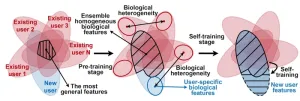(Press-News.org) A study led by researchers at the UCLA Jonsson Comprehensive Cancer Center has found that targeting a metabolic process in people with a specific genetic mutation could help treat glioblastoma, an aggressive brain cancer.
The genetic alteration — a deletion in a gene called CDKN2A — is present in about 60% of people who have glioblastoma. The mutation causes changes in the way lipids are distributed in cancer cells, which in turn makes the cancer cells vulnerable to being destroyed. The discovery, published in Cancer Cell, could suggest a path toward the development of targeted therapies that specifically target that vulnerability.
“Each patient’s tumor can have a unique combination of genetic alterations,” said David Nathanson, co-senior author of the study and an associate professor of molecular and medical pharmacology at the David Geffen School of Medicine at UCLA. “Because all of these tumors are different, we need to understand how certain genetic changes can affect tumor metabolism in order to identify potential targets for future treatments.”
Scientists believe that disrupting cancer cells’ metabolism — the way that they process energy and nutrients in order to survive, grow and invade healthy cells — could be one key to new and effective treatments.
Developing new ways to treat glioblastoma is imperative, said Nathanson, who also is a member of the Jonsson Cancer Center. Glioblastomas are lethal brain tumors that grow quickly, and currently there are few treatment options. The average lifespan of someone diagnosed with the brain tumor is just 12 to 15 months, and only about 5% of people diagnosed with glioblastoma are alive five years after their diagnosis. President Joe Biden’s son Beau and Senator John McCain both died from the disease.
Looking for possible patterns in the way the cancer cells process fats — which might indicate that they could be vulnerable to medicine — the researchers analyzed data from 84 glioblastoma tumors, 42 human cell lines and 30 mouse models of glioblastoma. They noticed some irregularities with CDKN2A, the gene that is mutated in a majority of people with glioblastoma.
They found that the gene rewires lipid metabolism to work in a different way than cells without that genetic alteration. And when the CDKN2A gene is missing, the way cancer cells process fats makes them more vulnerable to cell death, or ferroptosis.
The team then used a drug that targets this process and found glioblastoma cells with the genetic alteration in CDKN2A were highly susceptible to cell death, while the glioblastoma cells that did not have the genetic alteration were insensitive to the drug.
“We discovered that CDKN2A may be a key regulator of cancer cell metabolism, which has never before been shown in the context of cancer, even though it is deleted in other types of cancer,” Nathanson said. “Importantly, we found that CDKN2A deletion rewires lipid metabolism not just in our models but also in tumors from glioblastoma patients. This indicates that this metabolic vulnerability could one day be a target of therapy in glioblastoma patients.”
While there is no existing drug that could penetrate the brain to target the process studied by the UCLA scientists, the study provides strong rationale to develop one, Nathanson said.
Steven Bensinger, the Sherie and Donald Morrison Professor of Immunology and co-senior author of the study, said another important aspect of the work is that it could shed new light on how diet and other lifestyle factors could influence cancer progression and patients’ responses to therapy.
“Our data indicates that CDKN2A-deleted cancer cells shift the type of lipids used to build their cellular membranes, and that this difference can be exploited to kill tumors,” Bensinger said. “This opens up the exciting possibility that prescribing special diets containing the ‘wrong’ lipids could make them more susceptible to therapy or reduce tumor growth.”
The database of the 156 glioblastoma samples that the investigators analyzed is now available to researchers worldwide; the team has also expanded the number of samples in the database to more than 500, which the scientists hope will help them identify additional relationships between cancer-fighting genes and specific types of lipids used by brain cancer.
The study’s other co-senior author is Scott Dixon of Stanford University. The co-first authors are UCLA doctoral candidates Jenna Minami and Nicholas Bayley, and Danielle Morrow, who earned her doctorate from UCLA in 2021. Other co-authors are Elizabeth Fernandez, Jennifer Salinas, Christopher Tse, Henan Zhu, Baolong Su, Rhea Plawat, Anthony Jones, Alessandro Sammarco, Dr. Linda Liau, Thomas Graeber, Kevin Williams and Dr. Timothy Cloughesy, all of UCLA.
The study was funded in part by grants from the National Institutes of Health and the Department of Defense.
END
A metabolic process in cancer cells could unlock a possible treatment for glioblastoma
UCLA-led study could lead to new strategy for treating aggressive brain cancer
2023-05-25
ELSE PRESS RELEASES FROM THIS DATE:
Can sugar and fat influence immune cell responses?
2023-05-25
LA JOLLA, CA—A population of unconventional white blood cells has recently captured the attention of immunologists and clinicians alike. Unlike conventional T cells, which circulate throughout the body in our blood, mucosal-associated invariant T (MAIT) cells are largely found in tissues where they provide immune protection against a broad range of diseases.
MAIT cells are highly abundant in humans. Although they make up only 2 percent of the lymphocytes in blood, MAIT cells account for 10 to 40 percent of lymphocytes in the liver, and they are common in tissues such as lungs. Still, much about MAIT cell biology and clinical function remains unknown.
In ...
County-level maternal vulnerability and preterm birth
2023-05-25
About The Study: The findings of this study using data for 3.6 million births suggest that the Maternal Vulnerability Index (MVI), a novel county-level index designed to quantify maternal vulnerability to adverse health outcomes, was associated with preterm birth even after adjustment for individual-level confounders. The MVI is a useful measure for county-level preterm birth risk that may have policy implications for counties working to lower preterm rates and improve perinatal outcomes.
Authors: Sara C. Handley, M.D., M.S.C.E., Children’s Hospital of Philadelphia, is the corresponding author.
To ...
Deep learning for detection and symptom severity assessment of autism spectrum disorder
2023-05-25
About The Study: In this diagnostic study of 45 children with autism spectrum disorder (ASD) and 50 with typical development, a deep learning system trained on videos acquired using a joint attention–eliciting protocol for classifying ASD versus typical development and predicting ASD symptom severity showed high predictive performance. This new artificial intelligence–assisted approach based predictions on participants’ behavioral responses triggered by social cues. The findings suggest that this method may allow digital measurement of joint attention; however, follow-up studies are necessary for further validation.
Authors: Yu ...
Using AI, scientists find a drug that could combat drug-resistant infections
2023-05-25
CAMBRIDGE, MA -- Using an artificial intelligence algorithm, researchers at MIT and McMaster University have identified a new antibiotic that can kill a type of bacteria that is responsible for many drug-resistant infections.
If developed for use in patients, the drug could help to combat Acinetobacter baumannii, a species of bacteria that is often found in hospitals and can lead to pneumonia, meningitis, and other serious infections. The microbe is also a leading cause of infections in wounded soldiers in Iraq and Afghanistan.
“Acinetobacter can survive on hospital doorknobs and equipment ...
Monkey model offers clues for potential widespread HIV cure in people
2023-05-25
PORTLAND, Oregon -- New animal research is helping explain why at least five people have become HIV-free after receiving a stem cell transplant. The study’s insights may bring scientists closer to developing what they hope will become a widespread cure for the virus that causes AIDS, which has infected about 38 million people worldwide.
Published in the journal Immunity, the Oregon Health & Science University-led study describes how two nonhuman primates were cured of the monkey form of HIV after receiving a stem cell transplant. ...
OU professor leading research for next steps in monitoring bat coronaviruses
2023-05-25
Since the emergence of SARS in 2002, coronaviruses have been recognized as potential pandemic threats. This emergence highlights a need for evidence-based strategies to monitor bat coronaviruses. Daniel Becker, Ph.D., a researcher at the University of Oklahoma, is collaborating with other scientists nationwide to determine directions for future research.
Becker, an OU assistant professor of biology, was the senior author of a paper published in Nature Microbiology. The study’s lead author was Lily Cohen, a medical student at the Icahn ...
New framework for defining long COVID highlights twelve signature symptoms
2023-05-25
Long COVID, or Post-Acute Sequelae of SARS-CoV-2 infection (PASC), includes a wide range of symptoms that present or persist more than 30 days after COVID-19 infection. With over 650 million people globally having been infected with SARS-CoV-2, long COVID represents a significant public health concern that affects quality of life, earnings, and health care costs. To better understand the prevalence and severity of symptoms, the National Institutes of Health (NIH) launched Researching COVID to Enhance Recovery (RECOVER-Adult), ...
Development of a definition of Long COVID
2023-05-25
About The Study: In this analysis of data from 9,764 participants in the RECOVER adult cohort, a prospective longitudinal cohort study, 37 symptoms across multiple pathophysiological domains were identified as present more often in SARS-CoV-2–infected participants at six months or more after infection compared with uninfected participants. A preliminary rule for identifying postacute sequelae of SARS-CoV-2 infection (PASC), also known as long COVID, was derived based on a composite symptom score. As a first step to providing a framework for other investigations, iterative refinement that further incorporates other clinical features is needed ...
Identifying the gut bacteria that threaten neonatal babies
2023-05-25
Researchers from the Quadram Institute and University of East Anglia have identified what makes some strains of gut bacteria life-threatening in pre-term babies.
The findings will help identify and track dangerous strains and protect vulnerable neonatal babies.
A major threat to neonatal babies with extremely low birth weight is necrotising enterocolitis (NEC).
Rare in full term babies, this microbial infection exploits vulnerabilities destroying gut tissue leading to severe complications. Two out of five cases are fatal.
One bacterial species that causes especially sudden and severe disease is Clostridium perfringens. These ...
CityU researchers develop a self-supervised AI adaptation framework to enhance sensing accuracy of EMG devices
2023-05-25
Surface electromyography (EMG) has been widely used to measure the electrical activity of muscles. However, the variability in EMG sensing signals due to biological differences of different users significantly degrades the performance and potential of EMG systems. Recently, researchers from City University of Hong Kong (CityU) developed a deep learning-based framework called EMGSense, which can achieve high sensing performance for new users using AI self-training techniques. This opens a new path for developing more advanced and accurate wearable EMG devices in areas like neurorehabilitation and virtual reality.
This ...
LAST 30 PRESS RELEASES:
The Lancet Obstetrics, Gynecology, & Women’s Health: Taking paracetamol during pregnancy does not increase risk of autism, ADHD or intellectual disabilities, confirms new gold-standard evidence review
Taking paracetamol during pregnancy does not increase risk of autism, ADHD or intellectual disabilities
Harm reduction vending machines in New York State expand access to overdose treatment and drug test strips, UB studies confirm
University of Phoenix releases white paper on Credit for Prior Learning as a catalyst for internal mobility and retention
Canada losing track of salmon health as climate and industrial threats mount
Molecular sieve-confined Pt-FeOx catalysts achieve highly efficient reversible hydrogen cycle of methylcyclohexane-toluene
Investment in farm productivity tools key to reducing greenhouse gas
New review highlights electrochemical pathways to recover uranium from wastewater and seawater
Hidden pollutants in shale gas development raise environmental concerns, new review finds
Discarded cigarette butts transformed into high performance energy storage materials
Researchers highlight role of alternative RNA splicing in schizophrenia
NTU Singapore scientists find new way to disarm antibiotic-resistant bacteria and restore healing in chronic wounds
Research suggests nationwide racial bias in media reporting on gun violence
Revealing the cell’s nanocourier at work
Health impacts of nursing home staffing
Public views about opioid overdose and people with opioid use disorder
Age-related changes in sperm DNA may play a role in autism risk
Ambitious model fails to explain near-death experiences, experts say
Multifaceted effects of inward foreign direct investment on new venture creation
Exploring mutations that spontaneously switch on a key brain cell receptor
Two-step genome editing enables the creation of full-length humanized mouse models
Pusan National University researchers develop light-activated tissue adhesive patch for rapid, watertight neurosurgical sealing
Study finds so-called super agers tend to have at least two key genetic advantages
Brain stimulation device cleared for ADHD in the US is overall safe but ineffective
Scientists discover natural ‘brake’ that could stop harmful inflammation
Tougher solid electrolyte advances long-sought lithium metal batteries
Experts provide policy roadmap to reduce dementia risk
New 3D imaging system could address limitations of MRI, CT and ultrasound
First-in-human drug trial lowers high blood fats
Decades of dredging are pushing the Dutch Western Scheldt Estuary beyond its ecological limits
[Press-News.org] A metabolic process in cancer cells could unlock a possible treatment for glioblastomaUCLA-led study could lead to new strategy for treating aggressive brain cancer


